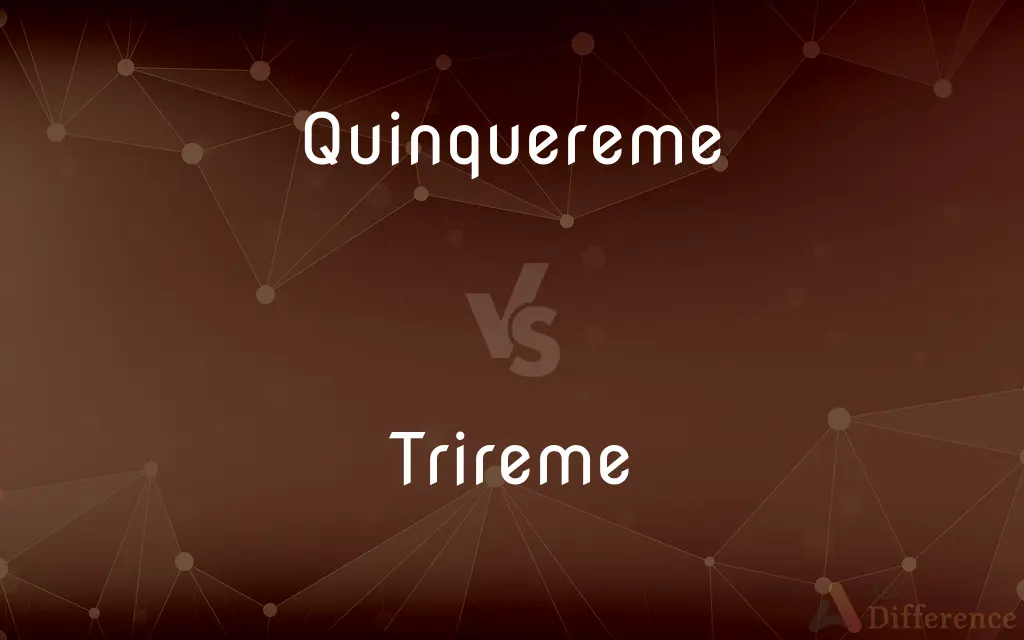Quinquereme vs. Trireme — What's the Difference?
Edited by Tayyaba Rehman — By Fiza Rafique — Updated on April 3, 2024
Quinqueremes, with their five rows of oarsmen, were larger and more powerful than triremes, which featured three rows.

Difference Between Quinquereme and Trireme
Table of Contents
ADVERTISEMENT
Key Differences
Quinqueremes were ancient warships distinguished by their five rows of oars on each side, designed for strength and size, enabling them to carry more soldiers and equipment. Triremes, on the other hand, were older and featured three rows of oars. They were renowned for their speed and maneuverability, which made them the dominant warship in the early naval battles of ancient Greece.
This quinquereme made them formidable opponents in naval warfare, particularly in engagements where boarding enemy ships was the primary tactic. They were a key component of many Mediterranean navies, especially during the Hellenistic periods following the conquests of Alexander the Great. The agility of triremes allowed for innovative tactics such as the ramming of enemy ships, a maneuver that required precision and skill from both the rowers and the commander.
Quinqueremes required a larger crew to man the oars, which often meant a higher cost for construction and maintenance. Their size and crew requirements made them a significant investment for ancient naval powers, necessitating substantial economic resources. Triremes, while still requiring a considerable crew, were less expensive to build and maintain in comparison to quinqueremes. This made them a more accessible option for city-states and empires with lesser economic power but still eager to maintain a formidable naval presence.
The design of quinqueremes with more rows of oars allowed for a higher deck, providing an advantage in boarding actions against enemy ships. This elevated platform made it easier for soldiers to fight from a height advantage, increasing their effectiveness in close combat. In contrast, the lower profile of triremes made them less effective in boarding actions but provided a tactical advantage in terms of speed and the ability to outmaneuver larger ships. Their design was optimized for ramming, a tactic that required getting close to the enemy with speed and hitting them at the right angle to cause maximum damage.
Comparison Chart
Rows of Oars
Five
Three
ADVERTISEMENT
Size & Power
Larger and more powerful, capable of carrying more soldiers and equipment.
Smaller, prioritizing speed and maneuverability.
Crew Size
Requires a larger crew, increasing construction and maintenance costs.
Smaller crew, less expensive to build and maintain.
Tactical Advantage
Better suited for boarding actions due to higher decks.
Excelled in ramming tactics due to agility.
Historical Period
Flourished during the Hellenistic periods.
Dominated early naval battles of ancient Greece.
Compare with Definitions
Quinquereme
The quinquereme required a large crew for its oars, making it a significant investment for any navy.
Manning a quinquereme required skilled oarsmen and a coordinated effort.
Trireme
The trireme was the dominant warship in early ancient Greek naval battles.
In the battle, the agility of the trireme was unmatched.
Quinquereme
A large ancient warship with five rows of oars on each side, used predominantly in the Mediterranean.
The quinquereme, with its imposing size, dominated the sea battle.
Trireme
Triremes required a skilled crew to maximize their tactical advantages.
Coordination among the trireme's oarsmen was essential for executing rapid maneuvers.
Quinquereme
Quinqueremes played a crucial role in naval warfare during the Hellenistic periods.
The fleet of quinqueremes was a testament to the naval power of the Hellenistic kingdoms.
Trireme
Less expensive to build and maintain than larger ships, triremes were accessible to many naval powers.
The city-state's fleet of triremes was a formidable defense against invaders.
Quinquereme
Designed for strength, the quinquereme could carry more soldiers and equipment than its counterparts.
The quinquereme's decks were crowded with soldiers ready for boarding action.
Trireme
Its design focused on enabling swift, tactical movements and ramming attacks.
The trireme's crew practiced ramming maneuvers diligently.
Quinquereme
Its higher decks offered an advantage in boarding actions against enemy ships.
From the high decks of the quinquereme, soldiers launched their attack.
Trireme
An ancient warship with three rows of oars, known for its speed and maneuverability.
The trireme sliced through the waves, ready to ram its opponent.
Quinquereme
(history) An ancient Carthaginian or Greek galley having three banks of oars, rowed by five oarsmen: two to an oar in each of the upper rows, and one to the lower oar.
Trireme
A trireme (, TRY-reem; derived from Latin: trirēmis "with three banks of oars"; Ancient Greek: τριήρης triērēs, literally "three-rower") was an ancient vessel and a type of galley that was used by the ancient maritime civilizations of the Mediterranean, especially the Phoenicians, ancient Greeks and Romans.The trireme derives its name from its three rows of oars, manned with one man per oar. The early trireme was a development of the penteconter, an ancient warship with a single row of 25 oars on each side (i.e., a single-banked boat), and of the bireme (Ancient Greek: διήρης, diērēs), a warship with two banks of oars, of Phoenician origin.
Quinquereme
A galley having five benches or banks of oars; as, an Athenian quinquereme.
Trireme
An ancient Greek or Roman galley or warship, having three tiers of oars on each side.
Trireme
A galley with three banks of oars, one above the other, used mainly as a warship.
Trireme
An ancient galley or vessel with tree banks, or tiers, of oars.
Trireme
Ancient Greek or Roman galley or warship having three tiers of oars on each side
Common Curiosities
How does a trireme differ from a quinquereme in design?
A trireme features three rows of oars and prioritizes speed and maneuverability over the quinquereme's size and power.
Why were triremes considered agile?
Triremes were agile due to their design, allowing for quick maneuvers and effective ramming tactics.
What role did triremes play in ancient Greek naval battles?
Triremes were crucial in early ancient Greek naval battles for their speed and tactical advantages in ramming enemy ships.
What were the main tactical advantages of quinqueremes?
Quinqueremes excelled in boarding actions due to their higher decks and larger carrying capacity for soldiers.
How did the crew requirements differ between quinqueremes and triremes?
Quinqueremes required a larger crew for their oars, making them more expensive to build and maintain than triremes.
What defines a quinquereme?
A quinquereme is an ancient warship with five rows of oars on each side, designed for strength and carrying capacity.
Can you explain the historical significance of quinqueremes?
Quinqueremes were significant in naval warfare during the Hellenistic periods, reflecting the naval power of Mediterranean kingdoms.
What made triremes less expensive than quinqueremes?
The smaller size and crew of triremes made them less expensive to build and maintain.
How did the design of quinqueremes benefit boarding actions?
The higher decks of quinqueremes provided a height advantage in close combat during boarding actions.
What tactical advantage did triremes have over quinqueremes?
Triremes had a tactical advantage in speed and maneuverability, allowing for effective ramming attacks.
Were quinqueremes used by all ancient Mediterranean navies?
Quinqueremes were primarily used by major Mediterranean powers, especially during the Hellenistic periods.
Did triremes and quinqueremes coexist in ancient naval fleets?
Yes, triremes and quinqueremes often coexisted in ancient naval fleets, serving different tactical roles.
Why were triremes so important to ancient Greek warfare?
Triremes were essential for their naval dominance, allowing Greek city-states to control sea routes and engage effectively in naval battles.
What was the main purpose of the five rows of oars in a quinquereme?
The five rows of oars in a quinquereme provided the power necessary for its large size and heavy load, enhancing its combat capabilities.
How did the trireme's design enhance its ramming capabilities?
The trireme's design, focusing on agility and speed, allowed it to execute precise ramming maneuvers against enemy ships.
Share Your Discovery

Previous Comparison
Roof vs. Rooftop
Next Comparison
Ascend vs. TranscendAuthor Spotlight
Written by
Fiza RafiqueFiza Rafique is a skilled content writer at AskDifference.com, where she meticulously refines and enhances written pieces. Drawing from her vast editorial expertise, Fiza ensures clarity, accuracy, and precision in every article. Passionate about language, she continually seeks to elevate the quality of content for readers worldwide.
Edited by
Tayyaba RehmanTayyaba Rehman is a distinguished writer, currently serving as a primary contributor to askdifference.com. As a researcher in semantics and etymology, Tayyaba's passion for the complexity of languages and their distinctions has found a perfect home on the platform. Tayyaba delves into the intricacies of language, distinguishing between commonly confused words and phrases, thereby providing clarity for readers worldwide.














































